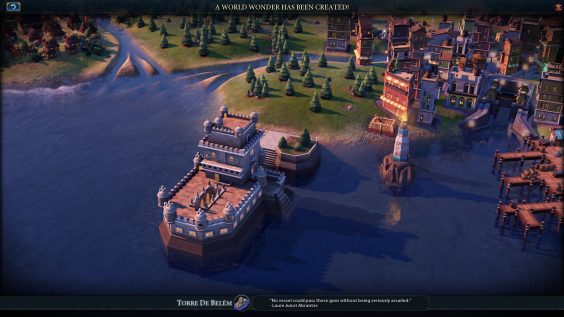
Introduction
Following this guide requires the Gathering Storm expansion.
It also assumes you have all other Civ 6 content, listed below, though it is not necessary to have these to utilise the key strategies of each civ.
- Pre-Rise and Fall content packs
- Vikings, Poland, Australia, Persia/Macedon, Nubia, Khmer/Indonesia
- Rise and Fall Expansion
- New Frontier content packs
- Maya/Grand Colombia, Ethiopia, Byzantium/Gauls, Babylon, Vietnam/Kublai Khan, Portugal
These content packs include exclusive civs, city-states, districts, buildings, wonders, natural wonders, resources, and a disaster, but not core game mechanics – all you need is the base game and the Gathering Storm expansion for those.
The stronger they rise, the further they fall. The powerful become complacent, and ignore the details that may make their realm stronger. So though we must understand them to survive, they neglect to understand us. And in that, we have the advantage. Come – let us end the tyranny of empires.
How to use this guide
This guide is divided into multiple sections explaining how best to use and play against this specific civ.
- The Outline details the mechanics of how the civilization’s unique features work and what their start bias is if they have one.
- The Victory Skew section describes to what extent the civ (and its individual leaders where applicable) is inclined towards particular victory routes. This is not a rating of its power, but an indicator of the most appropriate route to victory.
- Multiple sections for Uniques explain in detail how to use each special bonus of the civilization.
- Administration describes some of the most synergistic governments, government buildings, policy cards, age bonuses, pantheons, religious beliefs, wonders, city-states and Great People for the civ. Only the ones with the most synergy with the civ’s uniques are mentioned – these are not necessarily the “best” choices when playing as the civ for a given victory route.
- Finally, the Counter-Strategies discusses how best to play against the civ, including a consideration of leader agendas if the civ is controlled by a computer.
Note that all costs (production, science, etc.) mentioned within the guide assume a game played on the normal speed settings. To modify these values for other game speeds:
- Online: Divide by 2
- Quick: Divide by 1.5
- Epic: Multiply by 1.5
- Marathon: Multiply by 3
Glossary
Terminology used in this guide and not in-game is explained here.
AoE (Area of Effect) – Bonuses or penalties that affect multiple tiles in a set radius. Positive examples include Factories (which offer production to cities within a 6 tile radius unless they’re within range of another building of the same type) and a negative example is nuclear weapons, which cause devastation over a wide radius.
Beelining – Obtaining a technology or civic quickly by only researching it and its prerequisites. Some deviation is allowed in the event that taking a technology or civic off the main track provides some kind of advantage that makes up for that (either a source of extra science/culture or access to something necessary for a eureka or inspiration boost)
CA (Civ Ability) – The unique ability of a civilization, shared by all its leaders.
Compact empires – Civs with cities close together (typically 3-4 tile gaps between city centres). This is useful if you want to make use of districts that gain adjacency bonuses from other districts, or to maximise the potential of area-of-effect bonuses later in the game.
Dispersed empires – Civs with cities that are spread out (typically 5-6 tile gaps between city centres). Civs with unique tile improvements generally favour a more dispersed empire in order to make use of them, as do civs focused on wonder construction.
GWAM – Collective name for Great Writers, Artists and Musicians. All of them can produce Great Works that offer tourism and culture, making them important to anyone seeking a cultural victory.
LA (Leader Ability) – The unique ability of a specific leader. Usually but not always, they tend to be more specific in scope than civ abilities. Some leader abilities come with an associated unique unit or infrastucture.
Prebuilding – Training a unit with the intention of upgrading it to a desired unit later. An example is building Slingers and upgrading them once Archery is unlocked.
Sniping – Targeting a specific city for capture directly, ignoring other enemy cities along the way. Typically used in the context of “capital sniping” – taking a civ’s original capital as quickly as possible to contribute towards domination victory without leading to a drawn-out war.
Start bias – The kind of terrain, terrain feature or resource a civilization is more likely to start near. This is typically used for civilizations that have early bonuses dependent on a particular terrain type. There are five tiers of start bias; civs with a tier 1 start bias are placed before civs of tier 2 and so on, increasing their odds of receiving a favourable starting location.
Complete information on start biases within the game can be found in the Civilizations.xml file (find the Civ 6 folder in Steam’s program files, then go through the Base, Assets, Gameplay and Data folders to find the file). DLC and Expansion civs have a similarly-named file in their corresponding folders.
Super-uniques – Unique units that do not replace any others. Examples include India’s Varu and Mongolia’s Keshigs.
Tall empires – Empires that emphasise city development over expansion, usually resulting in fewer, but bigger, cities.
Uniques – Collective name for civ abilities, leader abilities, unique units, unique buildings, unique districts and unique improvements.
UA (Unique Ability) – A collective name for leader abilities and civ abilities.
UB (Unique Building) – A special building which may only be constructed in the cities of a single civilization, which replaces a normal building and offers a special advantage on top.
UD (Unique District) – A special district which may only be constructed in the cities of a single civilization, which replaces a normal district, costs half as much to build and offers some unique advantages on top.
UI (Unique Improvement) – A special improvement that can only be built by the Builders of a single civilization. “UI” always refers to unique improvements in my guides and not to “user interface” or “unique infrastructure”.
UU (Unique Unit) – A special unit that may only be trained by a single civilization, and in some cases only when that civilization is led by a specific leader.
Wide empires – Empires that emphasise expansion over city development, usually resulting in more, but smaller, cities.
Outline (Part 1/2)
Start Bias
The Mapuche have a tier 3 start bias towards all types of mountains except snow mountains. This increases the likelihood for them to start near a high-appeal area suitable for Chemamull.
Civilization Ability:Toqui
- All owned cities within 9 tiles of a Governor you have established gain 4 loyalty per turn.
- This bonus does not stack with itself (an owned city in range of multiple Governors will only gain +4 loyalty per turn) but will stack with Governor Victor’s Garrison Commander promotion.
- All cities of other civs within 9 tiles of a Governor you have established lose 4 loyalty per turn.
- This bonus does not stack with itself (a city of another civ in range of multiple Governors will only lose 4 loyalty per turn) but will stack with Governor Amani’s Emissary promotion.
- Cities with an established Governor have the following bonuses, which are tripled in cities not founded by the Mapuche:
- +5% culture
- +5% production
- Units trained in this city gain experience 10% faster.
Lautaro’s Leader Ability:Swift Hawk
- Gain +10 strength and religious strength against full civs in a Golden or Heroic Age, and against all Free Cities.
- Killing an enemy unit while both attacker and defender are within the corresponding civ’s city limits causes the city to lose 20 loyalty. This is doubled to 40 loyalty if the target is in a Golden or Heroic Age.
- This is applied based on where your unit is at the end of combat.
- This works when killing a unit while defending, as well as when killing during an attack.
- This does not apply when capturing civilian units without killing them, but can via actions such as theological combat.
- This does not apply against free cities.
Outline (Part 2/2)
Unique Unit:Malón Raider
A renaissance-era light cavalry unit which does not replace anything.
| Research | Obsoletion | Upgrades from | Upgrades to | Cost | Resource | Maintenance |

Gunpowder |

Military Science |
None | 
Cavalry 2. |
230 or or |
None | 4 |
*Purchasing units with faith requires the Grand Master’s Chapel government building, which requires either the medieval-era Divine Right or renaissance-era Exploration civics.
| Strength | Ranged Strength | Moves | Range | Sight | Negative Attributes | Positive Attributes |
| 55 |
N/A | 4 |
N/A | 2 |
None |
|
Notable Features
- Does not require strategic resources
- Costs 230 production/920 gold/460 faith (Coursers cost 200/800/400 or 9% less; Cavalry cost 330/1320/660 or 43% more)
- Has a maintenance cost of 4 (Coursers cost 3 gold per turn, Cavalry 5)
- Has 55 strength (medieval-era Coursers have 46 strength; industrial-era Cavalry have 62)
- +5 strength when fighting within four tiles of friendly territory
- Pillaging always costs just 1 movement point
- The Depredation promotion does not stack with this bonus, making it useless for Malón Raiders.
Unique Improvement:Chemamull
| Research | Terrain requirement | Constructed by | Base pillage yield |

Craftsmanship |
Any owned featureless land tile with at least 4 appeal (Breathtaking) | 
Builder |
25 |
| Defensive bonus | Direct yield | Adjacency yields | Miscellaneous bonus | Starting yield | Maximum theoretical yield |
| None | 1 |
None | Grants culture equal to 75% of this tile’s appeal, rounded down | 3 1 |
22 * 1 |
*The maximum possible appeal is 30 – the tile must be adjacent to both tiles of the Cliffs of Dover, a river, at least one unimproved old-growth woods while Governor Reyna (the Financier) with the Forestry Management promotion present, and the rest of the adjacent tiles either old-growth woods or city parks. Furthermore, the city would need to have the Golden Gate Bridge wonder, while your empire would need both the Eiffel Tower and Mausoleum at Halicarnassus wonders; the latter to allow the Great Engineers Alvar Aalto and Charles Correa to retire twice in the city.
Enhancements
| Research | Direct bonus | Adjacency bonus | Miscellaneous bonus | New starting yield | New theoretical maximum |

Flight |
None | None | Culture yield added to tourism | 3 3 1 |
22 2. 1 |
Victory Skew
In this section, the civ is subjectively graded based on how much it leans towards a specific victory type – not how powerful it is. Scores of 3 or more mean the civ has at least a minor advantage towards the victory route.
| Leader | 
Culture |

Diplomacy |

Domination |

Religion |

Science |
| Lautaro | 8/10 (Good) |
4/10 (Acceptable) |
9/10 (Ideal) |
7/10 (Good) |
4/10 (Acceptable) |
Culture is the second-best route for the Mapuche. Though this mostly relies on the tourism potential of the Chemamull unique improvement, the tile improvement is particularly strong in that role. Of course, you can also use your military advantages to eliminate civs that accumulate too much culture, lowering the threshold needed to win.
Diplomatic victory is the Mapuche’s weakest route, but notably among warfare-focused civs, the Mapuche can potentially take enemy cities without inflicting grievances. Draining loyalty by killing enemy units, and then capturing the resulting free city, does not create grievances unlike capturing the city directly. High culture yields also help with getting civics with bonus envoys, and eventually the Carbon Recapture project.
Domination victory is the best option for the Mapuche. The +10 strength bonus against civs in Golden Ages is the biggest unique strength bonus in the game, while Malón Raiders can deal good amounts of damage in their own right. Even entrenched cities surrounded by mountains aren’t necessarily safe if the Mapuche can kill enough units to flip them into free cities. Furthermore, extra experience gain for units trained in cities with Governors ensures units can stay strong after engaging in prolonged combat.
Religious victory can be surprisingly effective as the Mapuche as well. The strength bonus versus civs in Golden Ages works for theological combat – get some Apostles with the Debater promotion and you can kill enemy religious units in just 1-2 hits. To make things even better, killing units in theological combat can lower the loyalty of a nearby rival city – kill at least two religious units in quick succession and the nearby city will suffer yield penalties until it can recover to 75+ loyalty again. These yield penalties will hurt the faith output of the target civ, weakening their potential to react.
Finally, scientific victories rest on the Mapuche’s bonusproduction yields for cities with Governors, especially in non-founded cities, combined with the civ’s mountain start bias for strong campuses. Though the bonus to production is only 15% to seven cities at the most, it can have a decent impact.
Lautaro’s Leader Ability:Swift Hawk(Part 1/3)
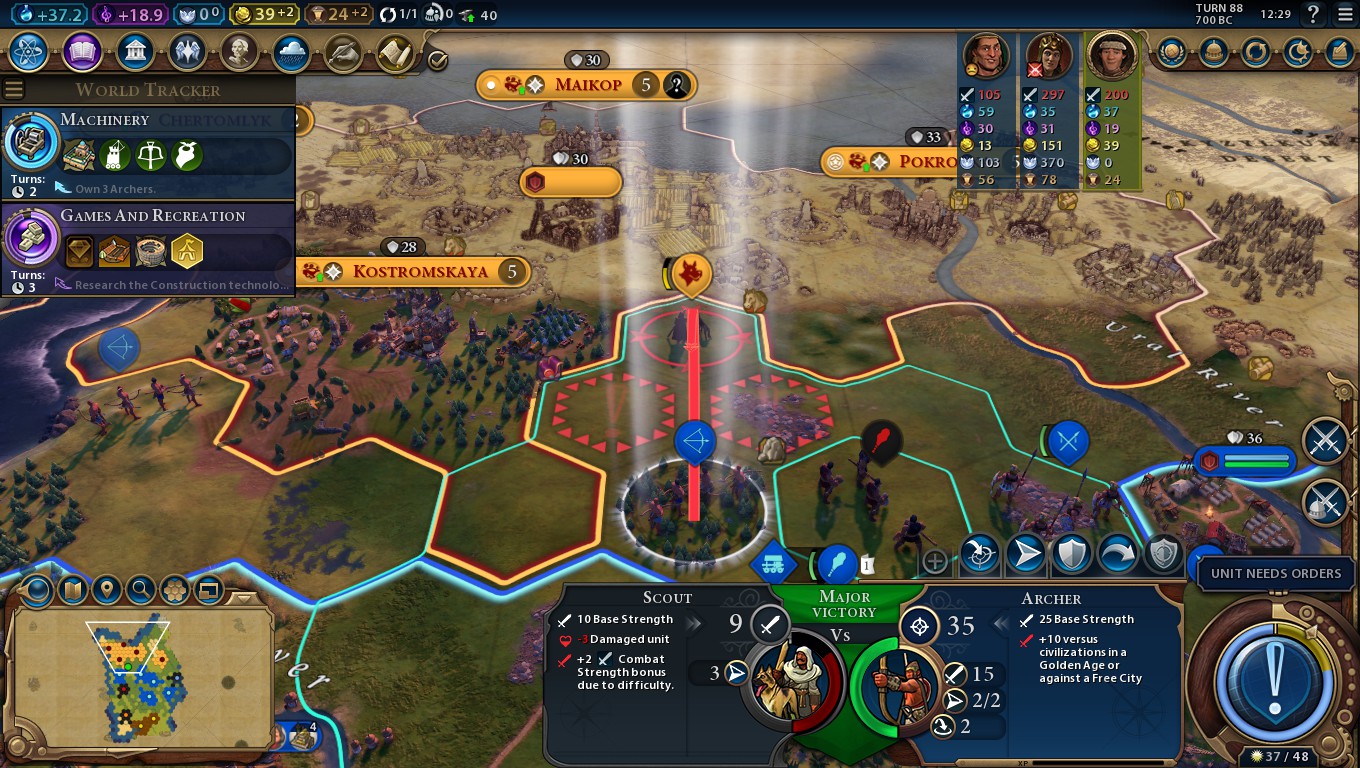
Sometimes, a civ seems impossible to take on in a war. Their cities are triple-reinforced with every kind of walls. Their fields are filled with military units. And their Golden Age is producing far too much loyalty pressure. Lautaro can break through this, however, and take even the strongest civs down – so long as you’re able to drop everything and initiate wars quickly.
Strength bonus vs. civs in Golden Ages
Golden and Heroic Ages are normally great moments for civs. Their cities get more loyalty and civs also get to exploit a strong dedication bonus. But for Lautaro, other civs entering a Golden Age isn’t a concern but an opportunity.
Preparation
You need to be able to start a war at a moment’s notice all throughout the game, so preparation is key. Training a few Slingers early on will help to keep you safe from Barbarians, and they can be upgraded into Archers for a more effective force. Getting a Battering Ram along with a couple of melee units like Swordsmen will be useful as well. Of course, while training up an initial army, don’t forget general development as well – you’ll want to expand to a few cities, improve luxuries, and so forth.
Getting your science generation to a good start will also be a good idea as you’ll eventually want to work your way to the renaissance-era Gunpowder technology for Malón Raiders. Thankfully, the Mapuche mountain start bias makes it easier to get a strong Campus or two early on.
Destroying the Golden Age
A new game era begins. Scythia has entered a Golden Age.
At the beginning of every game era, you have the opportunity to see which civs have just entered into Heroic, Golden, Normal or Dark Ages. If any civ that still has their original capital standing enters a Golden or Heroic Age, you should aim to start and complete a war with them before the age is finished, if possible. The +10 strength bonus is too good to go to waste, so don’t be afraid to denounce allies as soon as the alliance ends, ready for a formal war, if they enter into either age.
You may find that the only civs that have entered a Golden/Heroic Age are far away from your current location. That’s still manageable – you’ll have enough time to send your forces over, and loyalty problems can be addressed by capturing cities quickly (so they provide positive loyalty pressure to each other) and using Governors.
Usually, you can’t win by fighting civs in Golden/Heroic Ages alone. If you’ve exhausted those targets and still want something to fight, look for civs in Dark Ages. Civs in Dark Ages suffer a loyalty penalty in all their cities, making the loyalty-draining aspect of Lautaro’s leader ability more effective.
Predicting and Guiding Golden Ages
Reacting to the whims of other civs is all well and good, but a knowledgable player can work out when other civs are likely to hit Golden Ages, and plan accordingly. A skilled player can even help other civs cross the threshold into Golden Ages – but this is a tricky strategy to pull off.
When a civ constructs unique infrastructure (unique building, district or improvement), or trains a unique unit, they gain era score, making them more likely to get a Golden Age in the following era. In particular, civs that have two uniques arriving in the ancient or classical research eras are likely to hit a Golden Age by the time the classical game era starts. Some of the best examples include Babylon, Cree, Egypt, Nubia, Scythia and Sumeria.
Early on, clearing Barbarian encampments near your land is a great way of gaining era score. But nearly clearing an encampment, then letting another civ clear it, can help feed them era score.
As the game goes on, future Golden Ages can become a bit trickier to predict. That being said, it’s worth considering that civs that have been through Golden Ages already have higher thresholds for reaching the next, while civs that have been through Dark Ages have lower thresholds for future Golden Ages.
Civs that focus around constructing wonders are likely to enter Golden Ages multiple times, as wonder construction is one of the best ways of gaining era score. China, Egypt and France are notable examples of such civs. By avoiding building unnecessary wonders, you can ensure other civs get more era score out of it. You can always capture those wonders through warfare later.
Alternative Strategy: The Religious Angle
The strength bonus from Lautaro’s leader ability applies in theological combat – the most powerful unique bonus to it in the game. If you want to play the religious game, and you manage to successfully found a religion, this can be quite powerful. Your Missionaries can roam through enemy lands safe in the knowledge they can put up a fight against enemy Inquisitors and Apostles, while your Apostles can do some serious damage to enemy religious units.
To make things even better, other civs will be discouraged from declaring war to clear the religious units, as you can respond with an army with a +10 strength advantage. Even if your army is underdeveloped or a little outdated, you can still pose enough of a threat that civs may not want to risk that.
Lautaro’s Leader Ability:Swift Hawk(Part 2/3)
Loyalty-Draining and Bonus vs. Free Cities
This element of Lautaro’s leader ability is quite a strange one, and can be approached in multiple ways. The most common use for it is to weaken cities before you capture them, reducing their ability to respond to your attack. However, you can also use it to break through heavily-defended cities, or even devastate a civ through theological combat.
Explaining Loyalty
Before explaining what Lautaro’s leader ability can do for you, it’s useful to explain the loyalty mechanic itself. City-states are completely unaffected by the system, but otherwise, every city has a measure of loyalty from 0 to 100.
- Cities with 100 loyalty are at the maximum, and gain +1 culture from Monuments.
- Cities from 76 to 100 loyalty have no penalties to yields.
- Cities from 51 to 75 loyalty have a 25% penalty to all yields and growth.
- Cities from 26 to 50 loyalty have a 75% penalty to all yields and growth.
- Cities from 1 to 25 loyalty have a 100% penalty to all yields and growth.
- Cities with 0 loyalty will revolt and become a free city. All units within the city’s limits will be pushed out. Free cities may be captured by any civ by military means, or won with enough loyalty pressure.
Cities with low loyalty can be quite a burden for an empire, especially in conjunction with negative amenities as the penalties stack. Cities with both low amenities and loyalty can even cost your empire science and culture!
Cities can lose and gain loyalty by a variety of ways. Most methods are applied on a per-turn basis, though cities can’t lose more than 20 loyalty per turn by these (to prevent warmongers from instantly losing the cities they capture). There are many things that affect this:
- Pressure from citizens of other cities within 9 tiles. Cities near a lot of large cities owned by other civs may struggle to stay loyal to your own empire, while cities near plenty of large cities owned by you should be fine. The closer cities are to each other, the stronger loyalty pressure they impose on each other.
- During a Dark Age, you will suffer greater pressure from other civs’ citizens. During a Golden or Heroic Age, you will place more pressure on other civs’ cities.
- The presence of a Governor, which by default offers +8 loyalty per turn.
- If the city is occupied and doesn’t have a garrisoned unit, it suffers -5 loyalty per turn.
- Level of amenities.
- Deficit of 3 amenities or more: -6 loyalty
- Deficit of 1 or 2 amenities: -3 loyalty
- Surplus of 3 or 4 amenities: +3 loyalty
- Surplus of 5 amenities or more: +6 loyalty
- Religion:
- If the civ has founded a religion, but it’s different to the majority religion in the city: -3 loyalty
- If the civ has founded a religion and it’s the majority in the city: +3 loyalty
- The Colosseum wonder provides +2 loyalty to all cities within six tiles.
- The Statue of Liberty wonder makes all owned cities within six tiles always at 100 loyalty.
- Various Great People can provide permanent per-turn loyalty for their cities.
- Various policy cards can add or remove loyalty.
- The Audience Chamber government building makes cities of the civ without Governors lose 2 loyalty per turn.
- The Spy mission Forment Unrest reduces a city’s loyalty by at least 15 when complete.
Keep your empire compact with plenty of amenities and loyalty won’t be much of a problem. Warmongers, however, won’t have the luxury of a compact empire and will often struggle to secure amenities. As such, repositioning Governors and capturing cities quickly so they can impose pressure on each other is important.
Draining Loyalty by Killing Units
Now that we’ve covered what reducing loyalty does, we can consider how the loyalty-draining Lautaro’s leader ability can be a useful tool.
Any city can become a free city if you kill five of its units within the city limits with units of your own within the city limits – or just three units if they’re in a Golden/Heroic Age. This forces the other civ to either reconquer that city (dedicating their precious military resources) or wait for it to flip back into their control – if it’s possible. Making a city a free city also pushes any existing military units within the city limits out of them – which can help you make a retreat.
If a city becomes a free city, it will lose its outer defences (unless the game is progressed enough they get urban defences from the Steel technology) and will spawn two melee infantry units appropriate to the civ that lost the city’s technology level. Capturing a free city has no grievance penalty, and that combined with the loss of city walls and Lautaro’s +10 strength bonus against free cities makes it always worthwhile to try and take it out.
Still, draining a city’s loyalty can be quite hard to achieve, even with fairly well-defended cities or against civs like Scythia or Nubia which tend to have large quantities of units. Thankfully, killing just two units within a city’s limits (or one if the civ’s in a Golden/Heroic Age) will lower its loyalty below the 76-point threshold and start adding a 25% penalty to all its yields, making this ability still useful. Killing three units (two if the civ’s in a Golden/Heroic Age) drops a city below the 51-point threshold for a considerably more noticable 75% penalty.
Be careful killing units near cities with both very low health and loyalty – concentrate on capturing the city first instead. Otherwise, the moment the city becomes a free city, your enemy can simply take it back again.
In the case of isolated enemy cities, you can drain their loyalty until they become a free city, then leave them alone. They won’t flip back to enemy control, so there’s no need to commit more units to capturing them. If you’re unsure which civ a free city will flip to, a glowing civ icon will appear on the city, representing which civ has the most loyalty pressure on them and is therefore the most likely to win the city. You can also open the loyalty lens to see which civ has the most pressure on them.
While this ability mostly applies to conventional warfare, you can do some damage against a religious civ via theological combat as well. Put pressure on a civ by sending Missionaries over to convert some cities, and they should respond with religious units of their own. Then, you can send over Apostles to destroy them. Try to keep the area of religious combat focused so you can kill mutliple religious units in the same area in quick succession. If you engage in theological combat in a rival city surrounded by cities of a different civ, then you may even be able to flip that city, depriving the religious rival of it.
Lautaro’s Leader Ability:Swift Hawk(Part 3/3)
Through the Eras
The loyalty-draining aspect of Lautaro’s leader ability is tricky to use early in the game when enemy cities tend to have far fewer tiles and units. It is perhaps at its greatest potential around the renaissance and industrial eras, where cities have a lot of tiles but corps and armies aren’t commonplace yet (so there’s lots of units you can kill) and free cities won’t yet start immediately with urban defences.
Into the atomic era, Bombers can help deal with city defences even over long distances which can help you to deal newly-flipped free cities. You can also use Rock Bands with the Indie promotion to lower loyalty in targeted cities by 40 a time. You can guarantee Rock Bands start with the Indie promotion with the Hallyu wildcard, unlocked at the future-era Cultural Hegemony civic.
With enough faith, you can try combining Rock Bands with the Indie promotion and Apostles with the Debater promotion (+20 strength in theological combat). You can kill religious units with the Apostles to drain the city’s loyalty and follow up with the Rock Bands to drain even more loyalty.
Summary
- Always be ready for war, even if it means backstabbing former allies as soon as the alliance ends – the +10 strength bonus is too good to miss.
- Loyalty-draining can allow you to capture a city without creating grievances.
- Rock Bands with the Indie promotion can complement your loyalty-draining abilities, as well as theological combat.
Civilization Ability:Toqui
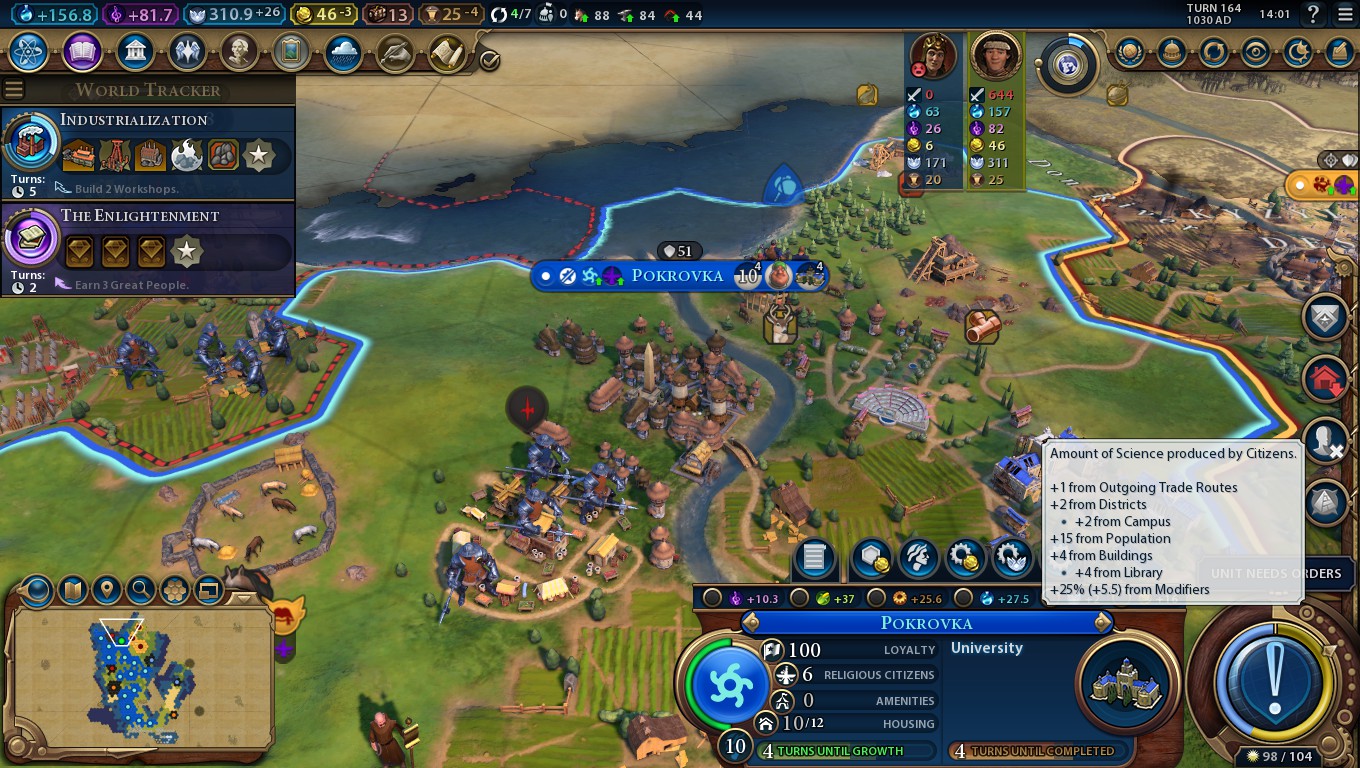
Bonus science! The 25% bonus consists of the 10% boost from Pingala, and the 15% boost from this ability.
Mapuche Governors offer an array of excellent bonuses on top of their intrinsic boosts, and are particularly well-equipped to support a game of aggressive expansion.
Obtaining Governor Titles
To use the Mapuche civ ability to its fullest extent, you’ll need lots of governor titles. You can obtain governor titles from the following civics:
- Early Empire (Ancient)
- State Workforce (Ancient)
- Defensive Tactics (Classical)
- Recorded History (Classical)
- Medieval Faires (Medieval)
- Guilds (Medieval)
- Civil Engineering (Industrial)
- Nationalism (Industrial)
- Mass Media (Modern)
- Mobilisation (Modern)
- Globalisation (Information)
- Social Media (Information)
- Near Future Governance (Information)
- Future Civic (Future) – grants +1 Governor title every time it is researched.
You can also gain governor titles from:
- Randomly from a tribal village on turn 30 or later
- Building a Government Complex
- Building any Government Complex building (up to a total of 3 titles)
- The medieval Great Merchant Irene of Athens
- The renaissance-era Casa de Contratación wonder (grants three titles)
- The industrial Great Merchant Adam Smith
At first glance, it might sound like a good idea to try and recruit all seven Governors as soon as possible, but some Governors have excellent promotions that are worth getting as soon as possible. Governor Pingala (the Educator) is worth recruiting early for his Researcher promotion for easy science. Governor Liang (the Surveyor) is also worth recruiting and promoting to the Parks and Recreation promotion, which enables you to build City Parks which in turn are an excellent source of appeal to complement Chemamull.
Loyalty Effects
Governor Pingala creates enough loyalty to keep Huilli Mapu secure!
Normally, moving a Governor to a city is a good way to keep it loyal thanks to their +8 loyalty bonus. For the Mapuche, however, they go one step further by offering an area-of-effect loyalty bonus when established, affecting all other cities within a nine-tile radius.
When you’re trying to boost loyalty in cities (for example, in those you’ve just captured), move at least two Governors to the front lines so they can provide extra loyalty to each other’s cities. Note that unlike the +8 loyalty bonus Governors add when present, the area-of-effect loyalty bonus only works when the Governors are fully established. Governor Victor (the Castellan) takes only three turns to establish rather than the usual five, so move him first – preferably to a city with the second-most loyalty problems, so he can provide his area-of-effect loyalty bonus to the one with the most loyalty problems.
Speaking of Governor Victor, giving him the Garrison Commander promotion makes him grant an extra +4 loyalty to cities within 9 tiles. In other words, any city with a different Governor in range of him will gain a massive +16 loyalty per turn – enough to resist the pressures of even civs in Golden Ages.
Interestingly, Mapuche Governors also lower the loyalty of the cities of other civs within 9 tiles. You can stack this with Governor Amani (the Diplomat)’s Emissary promotion to lower the loyalty of nearby rival cities by 6 points a turn. While you probably won’t flip many enemy cities this way, it might force other civs to move Governors from more lucrative spots in the core of their empire to loyalty management duty on their border.
Bonus Yields
Mapuche Governors offer +5% culture and production in their cities, which is a bonus generally too minor to notice. However, if the Governor is moved to a city that wasn’t founded by the Mapuche (typically a captured city), the bonus rises to +15%. Any former capitals you’ve captured will be excellent spots for Governors, as they may already have wonders present (which makes excellent Theatre Square adjacency bonuses), and often start near floodplain (excellent for Dams and Aqueducts, which make excellent Industrial Zone adjacency bonuses).
Alternatively, you can find captured cities with extensive amounts of open space or high-appeal areas and use the 15% culture boost in conjunction with high quantities of Chemamull improvements to zoom through the civics tree.
Bonus Experience
Units trained in a city with a Mapuche Governor gain experience 10% faster – or 30% faster if trained in a city that the Mapuche didn’t found. Combine this with a Barracks or Stable, Armoury and Military Academy, and you can get up to a 105% experience bonus for most kinds of land unit (A Harbour with a Lighthouse, Shipyard and Seaport for naval units) – in other words, you can create units that gain experience twice as fast.
This bonus is most useful when preparing for Malón Raiders. Gunpowder, the technology which allows you to train them, is boosted by the Armoury building, so it’s worth building one anyway. Training a Malón Raider in a non-founded city with Stables, an Armoury and an established Governor will provide an 80% experience boost, which will make more opportunities for the units to heal up with promotions and cut down the amount of downtime in wars.
Recon units gain considerably from boosted experience rates thanks to their extremely powerful Ambush promotion, which boosts their strength by 20 points. They don’t gain bonus experience from Barracks or Stables, but will from Armouries and Military Academies for a total of +80% experience gain (with a Governor in a non-founded city).
It can be tempting to just leave captured cities to work on basic infrastructure while you train military units in your core cities, but the Mapuche have a strong incentive to reverse this order. Consider training Builders in your core cities to improve (and fix the pillaged improvements) in your newly-captured cities so they can be reasonably productive.
Summary
- When boosting loyalty with your Governors, move two in so they can provide bonus loyalty to each other’s cities.
- Rather than simply recruiting all seven Governors as soon as possible, it helps to put some promotions into Governor Pingala (the Educator) for science, Governor Liang (the Surveyor) for city parks to boost Chemamull, and Governor Victor (the Castellan) for even more loyalty.
- Train military units in captured cities where possible.
Unique Improvement:Chemamull
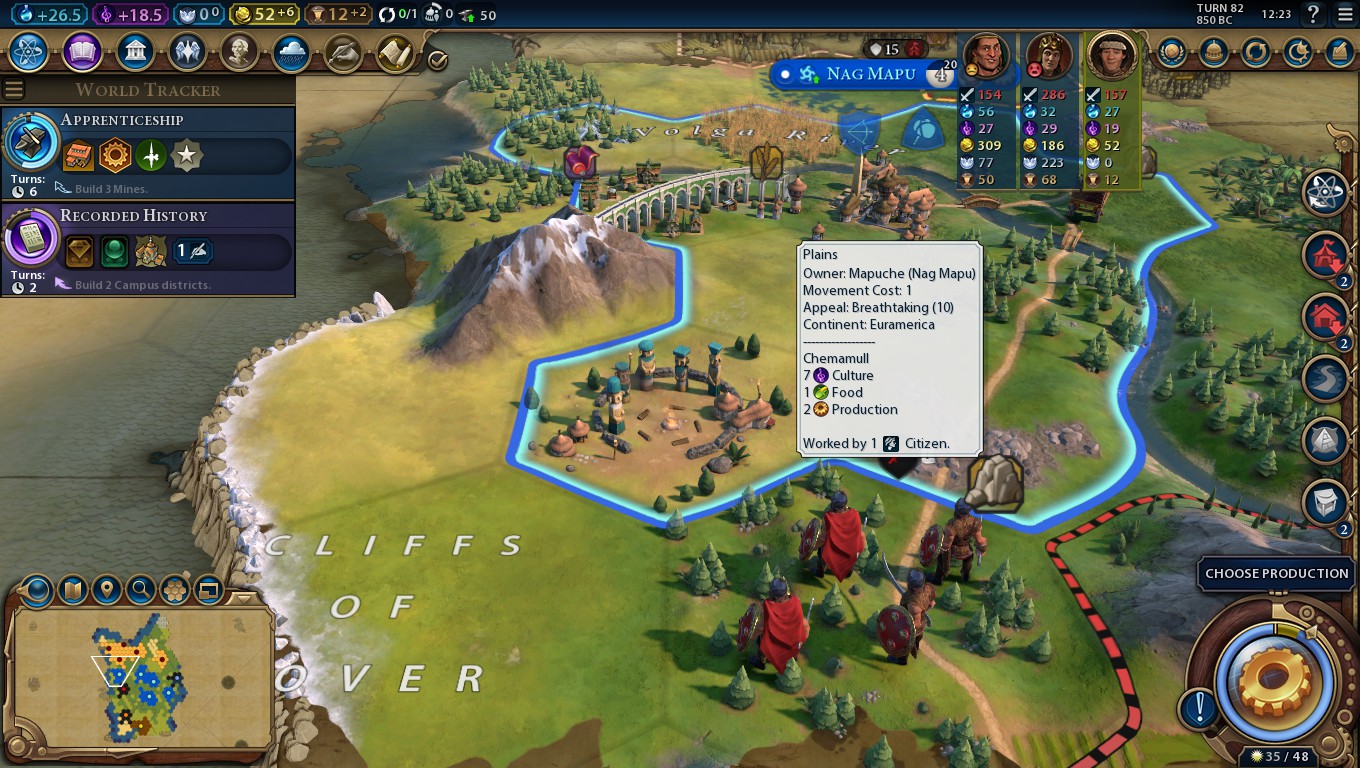
Chemamull set up the possibility of a cultural road to victory for the Mapuche. They have more tourism potential than any other unique improvement (with the possible exception of Egypt’s Sphinxes if you can exploit their appeal boost effectively enough). Even before that point, careful management of tile appeal can reward you with huge amounts of culture, helping you unlock useful things like corps and armies sooner.
Initial Usage
Tiles need at least 4 appeal before Chemamull can be placed there. Initially, that means seeking out coastal, natural wonder or mountain-adjacent spots. With a basic yield of 3 culture as well as 1 production, they offer a fairly strong yield early in the game – though at the classical-era Construction technology and the medieval-era Apprenticeship technology their production yield will be overtaken by lumber yields and mines respectively.
A simple way to boost tile appeal early on is to build an Entertainment Complex, Holy Site or Theatre Square district, which increases the appeal of adjacent tiles by 1. Mines, Quarries, Encampments, Industrial Zones and the like lower appeal in adjacent tiles, so be careful where you place them. Keep woods around for appeal bonuses, but clear rainforests and marshes if you need more appeal.
Boosting the Yields
Eventually you can influence tile appeal more directly. The most effective way to do so is to train Liang (the Surveyor) to the Parks and Recreation promotion and start building city parks. City Parks provide +2 appeal to adjacent tiles, though they cannot be placed adjacent to each other.
Here is a model of how city park and Chemamull placement can work. Obviously, this is an ideal model that doesn’t take into account the terrain, the need for food or the placement of districts, but every Chemamull in the image will have at least 6 appeal, and hence 4 culture. You may want to keep sea-adjacent spots free for Seaside Resorts later, which generate more tourism.
Note that old-growth woods can substitute for city parks as they provide just as much appeal, and can be improved with a lumber mill to provide a more useful yield than city parks can.
Once a city has enough city parks, move Liang to the next city you want to develop. She doesn’t need to be present in a city for city parks to function. To cut back on wasted time, train Builders in advance of her arrival in a city so you can be finished and move her to the next place sooner.
The Eiffel Tower wonder (available at the modern-era Steel technology) adds +2 appeal to every tile in your empire. Those 6-appeal Chemamull surrounded by city parks will now be up to 8 appeal, producing 6 culture (and hence 6 tourism with Flight) instead of 4.
The Great People Charles Correa and Alvar Aalto can also provide +2 and +1 appeal respectively for every tile within a city’s limits – use them on whichever city has the most Chemamull for the best results. If you have the Mausoleum at Halicarnassus wonder you can use those two Great People twice, bringing you up to a bonus 6 appeal (or 4-5 culture and tourism) per tile.
The Golden Gate Bridge wonder (available at the modern-era Combustion) technology offers both +4 appeal and +100% tourism from tile improvements in its city, but with the catch that it has quite specific placement requirements.
Summary
- Early on, well-positioned Chemamull can help you get through civics
- Use Liang (the Surveyor) to allow you to place city parks to maximise tile appeal to make Chemamull stronger
- Try to build or capture the Eiffel Tower wonder.
Unique Unit:Malón Raider
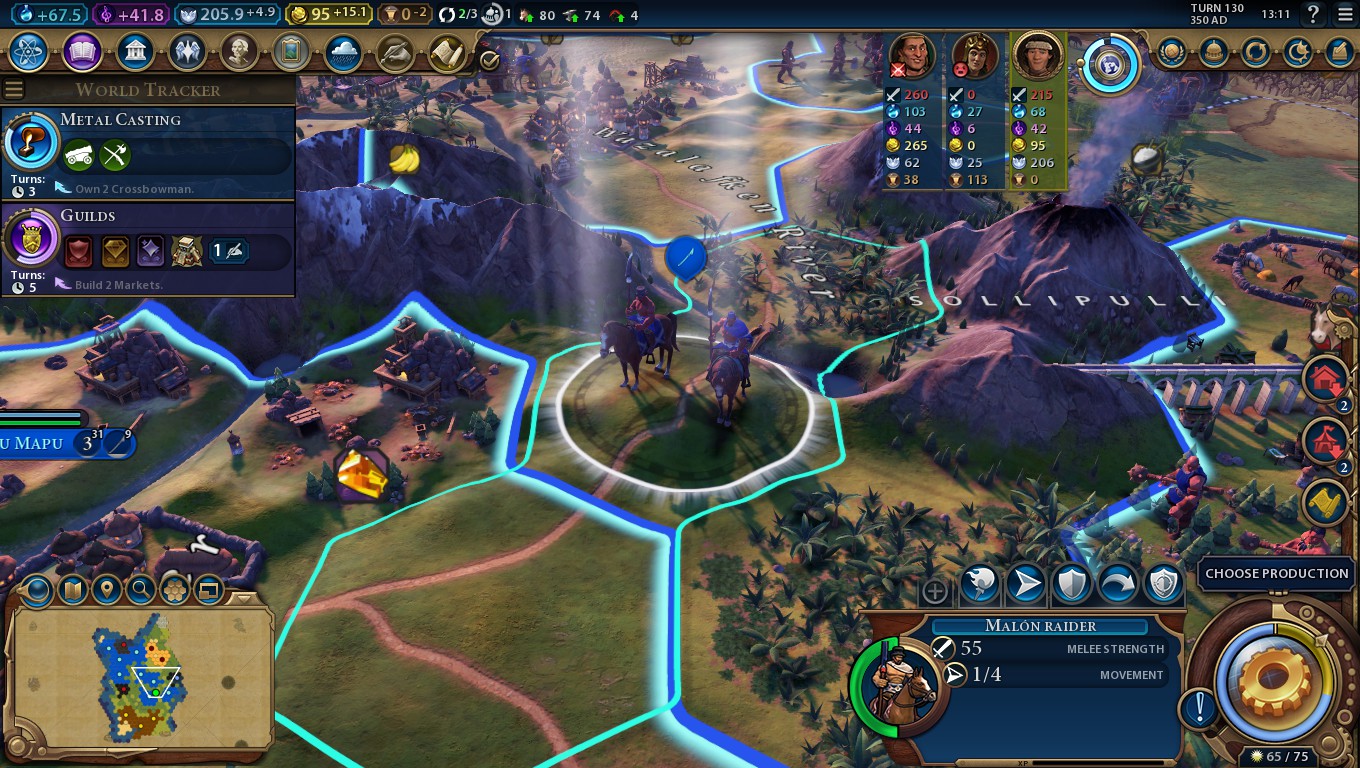
Malón Raiders are versatile units which fight well, have decent mobility, and thanks to their cheap pillaging, are good at staying alive.
Preparation
Malón Raiders become available at the renaissance-era Gunpowder technology. After you sort out necessary early Builder technologies, crucial technologies like Writing and maybe some extras to help with early warfare like Iron Working, you should try and beeline it. As you have to train Malón Raiders from scratch, getting the technology early is important. You’ll also want to build a Siege Tower or two to help the units handle city walls. You’ll need an Encampment with an Armoury for the eureka for Gunpowder – building it is a good idea anyway as securing a medieval or renaissance-era Great General will make your attack even stronger.
Meanwhile, on the civics tree, try to get to the medieval-era Divine Right civic so you can get the Chivalry military policy card, which allows you to train Malón Raiders faster. You can also take the Monarchy government and build the Grand Master’s Chapel building, letting you put any faith you get from pillaging back into unit production. Consider purchasing Bombards with faith as there’s no policy cards that boost their production and their siege abilities cover a key weakness of your UU.
Once you have Gunpowder, set plenty of cities (preferably captured cities with Encampments and Governors) to train Malón Raiders so you can get a decent force together quickly. You should be able to get that done before the renaissance game era begins – perhaps significantly before if you can research fast enough.
In Use
Malón Raiders have 55 strength at first, but 60 if they’re within four tiles of your own land. Obviously that makes them great in defence, but they’re also good offensively once you have a foothold in another civ’s lands. Against a civ in a Golden Age, they could be up to 70 strength – better than any industrial-era land unit! With siege support you should be able to take down most cities.
The ability of Malón Raiders to pillage for just one movement point is powerful in conjunction with the Raid military policy card (available at the classical-era Military Training civic). That increases the yield they gain from all pillaging actions by 50%, allowing them to heal most of their health by pillaging farms.
You can get a lot of yields quickly out of pillaging districts, though keep in mind you’ll need to repair them later if you intend to keep rather than raze the city. If you’re up against a civ with a unique land-based tile improvement, feel free to pillage those as much as you can spare time to do so – they’ll be destroyed when you take the city anyway.
Though Malón Raiders can handle Pikemen well, they can have trouble handling Pike and Shot units. The Caparison promotion helps, but that has the problem that the succeeding promotion (Depredation) is useless to them. You could alternatively head down the right-hand side of the promotion tree for Coursers and Double Envelopment; the latter of which doubles flanking bonuses allowing you to surround the Pike and Shot unit and deal good damage.
Conclusion
Malón Raiders will work effectively until AT Crews enter the game, or you unlock Helicopters. Their high mobility, decent strength and ability to pillage quickly for health makes them versatile, and a reliable part of your military for at least two eras. Even when you can’t successfully invade enemy civs with them, you can still sneak around city defences and pillage everything in sight.
Administration – Government and Policy Cards
Note that the Administration sections strictly cover the options that have particularly good synergy with the civ’s uniques. These are not necessarily the best choices, but rather options you should consider more than usual if playing this civ relative to others.
Government
Tier One
Although the strength bonus doesn’t affect Malón Raiders, Oligarchy is still a good choice for the extra experience boost, decent spread of policy card slots and use in early warfare if you want to fight civs in Golden Ages using Swordsmen of your own.
The Warlord’s Throne will be the most suitable government building.
Tier Two
Monarchy isn’t a bad option. It’s quicker to unlock than the other tier two governments, comes at the same civic as the helpful Chivalry policy card, and you can make good use of the military policy card slots. If you want to try out a religious game, take Theocracy and enjoy your huge advantage in theological combat.
The Grand Master’s Chapel government building lets you use the strong pillaging capability of Malón Raiders to grant you faith, which you can then use to buy more of them or to fund Naturalists and National Parks or Rock Bands later.
Tier Three
Fascism makes the best use of the Mapuche’s wartime bonuses. If you’re going for a cultural victory, Democracy may be a more appropriate alternative. Communism can also work well as the production bonus stacks nicely with the Mapuche civ ability for some highly-productive cities, though the arrangement of policy cards is slightly weaker for a cultural game.
As for your choice of tier three building, the War Department is often your best choice. Cultural players who need more Great Work slots may want to use the National History Museum instead.
Tier Four
Corporate Libertarianism is good for war-focused games as its production bonus helps with unit training – especially stacked with the Mapuche civ ability. Digital Democracy is a good alternative for cultural games.
Policy Cards
Ancient Era
Conscription (Military, requires State Workforce) – The Mapuche should keep a large army throughout the game to be prepared for other civs entering Golden Ages. That can cost a lot to maintain, so this policy card will help.
Ilkum (Economic, requires Craftsmanship) – Want to make use of Chemamull early? You’ll probably need extra Builders, so this policy card will come in handy.
Classical Era
Raid (Military, requires Military Training) – +50% pillaging effectiveness. Malón Raiders will be able to get considerable amounts of gold, faith and more from their pillaging efforts, and pillaging a farm will usually put them back at full health.
Veterancy (Military, requires Military Training) – Getting more experience out of units in cities with Governors is one thing, but if you really want to build on that advantage, you’ll want well-developed Encampments and Harbours. Encampments, Harbours and their buildings can be constructed faster with this policy card.
Medieval Era
Chivalry (Military, requires Divine Right) – Malón Raiders will be expensive to train without this policy card, so it’s important to pick up.
Professional Army (Military, requires Mercenaries) – Your need to be constantly ready for war when a new era arrives means you’ll often need to upgrade your units. This policy card will help.
Retinues (Military, requires Mercenaries) – Similarly, this will cut the strategic resource costs of unit upgrades.
Serfdom (Economic, requires Feudalism) – Grant your Builders lots of charges for constructing Chemamull and city parks.
Renaissance Era
(Religious) Religious Orders (Economic, requires Reformed Church) – Your religious units will be devastatingly powerful against civs in Golden Ages.
Industrial Era
Public Works (Economic, requires Civil Engineering) – Plenty of Builder charges for Chemamull and city parks will be made available.
Modern Era
Levee en Masse (Military, requires Mobilisation) – Support your large army as it waits ready to attack whoever enters a Golden Age.
Martial Law (Wildcard, Fascism only, requires Totalitarianism) – War weariness is obtained through combat, and is higher outside your own territory. Lautaro’s leader ability encourages you to fight a lot of battles in order to kill enemy units. As such, war weariness may be more of a problem than it would be for many other civs. This policy card will help with that.
Propaganda (Military, requires Mass Media) – Also helps to reduce war weariness.
Atomic Era
After Action Reports (Military, requires Rapid Deployment) – Get an even bigger advantage to experience gain on your units.
Future Era
Hallyu (Wildcard, requires Cultural Hegemony) – Allows you to consistently give Rock Bands the Indie promotion to drain loyalty – combine that with some theological or regular combat to rapidly make cities into free cities.
Space Tourism (Wildcard, requires Exodus Imperative) – Chemamull and the Mapuche civ ability together makes the Mapuche a contender for having a high number of domestic tourists. Taking this wildcard slows down cultural civs’ efforts to become culturally dominant over you, thus slowing down their attempts to win the game.
Administration – Age Bonuses and World Congress
Age Bonuses
Only bonuses with notable synergy with the civ’s uniques are covered here.
(Religious) Exodus of the Evangelists (Golden Age, Classical to Renaissance eras) – Extra movement for religious units makes it easier to use the strength bonus. If you haven’t got a religion yet, you also have a chance to grab some bonus Great Prophet Points.
To Arms! (Golden Age, Industrial to Information eras) – If another civ has entered a Golden Age at the same time as you, this is a good dedication to take. You can use the special casus belli without the usual 5-turn waiting period, and enjoy a huge reduction in warmonger penalties and war weariness from that war.
Cyber Warfare (Dark Age, Information to Future eras) – Helps you kill enemy units of the information and future eras faster, allowing you to drain the loyalty of enemy cities faster.
World Congress
How you should vote in the World Congress will often be specific to your game – if you have a strong rival, for example, it might be better to vote to hurt them than to help yourself. Furthermore, there may be general bonuses to your chosen victory route or gameplay which are more relevant than ones that have stronger synergy with civ-specific bonuses. Otherwise, here’s a list of key votes that have high relevance for this civ relative to other civs.
Deforestation Treaty – Effect A (Clearing features of the chosen type yields gold equal to the production and/or food) on rainforest if you have plenty in your territory.
Rainforests lower tile appeal, which gets in the way of Chemamull placement. As such, it’s nice to get an added bonus on top when clearing them.
Migration Treaty – Effect A (+20% faster population growth but -5 loyalty per turn in this player’s cities) on a rival
Slows the rate at which the civ’s loyalty will recover, making every unit you kill close to their cities more impactful.
Urban Development Treaty – Effect A (+100% production towards buildings in this district) on Encampments or Harbours
Develop Encampments and Harbours in captured cities, move in Governors and enjoy a significant boost to the experience gain of the units they train.
World Religion – Effect A (+10 strength for all religious units of this faith) on your own founded religion
Allows you to get an enormous edge in theological combat, letting you drain the loyalty of enemy cities with ease.
Administration – Pantheons, Religion and City-States
Pantheons
Earth Goddess – You’ll want plenty of breathtaking tiles for Chemamull. Add this pantheon and they can start generating faith as well.
God of the Forge – Be prepared for war early on, and you can make the most of the Mapuche civ ability and its +10 strength bonus versus civs in Golden Ages, rather than waiting until the renaissance era.
Religious Beliefs
You can have one founder, one follower, one enhancer and one worship belief.
Defender of the Faith (Enhancer) – The main reason to take this belief is to deny it to anyone else. Defender of the Faith partially cancels out the Mapuche +10 strength bonus versus civs in Golden Ages.
(Religious) Missionary Zeal (Enhancer) – Having strong religious units is one thing, but if you want to use that strength, you’ll want your religious units to be more mobile than those of other civs.
Warrior Monks (Follower) – Warrior Monks are often tricky to use due to their relatively low starting strength. The Mapuche civ ability not only can put them up to 40 strength to begin with, but also allows them to gain experience faster to become even stronger. That makes them great units to have around in the time before you can start training Malón Raiders.
City-States
(Religious) Armagh (Religious) – After a religious victory? You’ll want to engage in theological combat a lot, but that means every now and again you’ll have to send your Apostles home to heal up. Armagh makes the process easier thanks to its unique Monastery improvement, which allows religious units to heal up as if it was a Holy Site, and can be placed closer to the front lines.
Kabul (Militaristic) – Gain experience even faster.
Lahore (Militaristic) – You can buy the unique Nihang unit, and gain all their powerful promotions quickly if you’re suzerain over Lahore.
Nazca (Religious) – Nazca Lines provide +1 appeal and extra yields to adjacent tiles, making them good complements to the Chemamull improvement.
(Religious) Yerevan (Religious) – Apostles with the Debater promotion against a civ in a Golden Age can kill most religious units in a single hit. Yerevan guarantees you can always pick that promotion.
Administration – Wonders and Great People
Wonders
Pyramids (Ancient era, Masonry technology) – The Chemamull/city park formation requires a lot of Builder charges, and the Pyramids can help you to obtain more.
Colosseum (Classical era, Games and Recreation civic) – Aim to capture this wonder when invading another civ. That way, they lose the loyalty benefits and will be more affected by Lautaro’s leader ability.
Mausoleum at Halicarnassus (Classical era, Defensive Tactics civic) – Not a bad wonder to capture if you can’t build it yourself. It lets you use the Great Engineers Alvar Aalto and Charles Correa twice, helping you get even more appeal.
Statue of Liberty (Industrial era, Civil Engineering civic) – This wonder can be an annoying roadblock to Lautaro’s leader ability, as it prevents cities of the same civ within its radius from ever falling below 100% loyalty. Either build it yourself to deny other civs that ability, or aim to capture the city that has built it before you take other cities in the area off the civ.
Eiffel Tower (Modern era, Steel technology) – Bonus appeal to all your tiles means more culture from Chemamull, and hence more tourism.
Golden Gate Bridge (Modern era, Combustion technology) – Boosts the appeal of tiles in its city considerably, and doubles the tourism of improvements in its city on top for some extremely powerful Chemamull.
Great People
Classical Era
Trưng Trắc (Great General) – The Mapuche incentive to fight a lot of units can cause you to gain a lot of war weariness, so retiring Trưng Trắc is helpful.
Medieval Era
Rajendra Chola (Great Admiral) – Higher strength for all naval units helps you kill enemy units and drain their cities’ loyalty.
Industrial Era
Gustave Eiffel (Great Engineer) – Gustave Eiffel arrives just in time for his own wonder at the Steel technology. Use him to rush it to completion and enjoy an empire-wide appeal bonus.
Modern Era
Alvar Aalto (Great Engineer) – Provides +1 appeal to all tiles in their city.
Joaquim Marques Lisboa (Great Admiral) – Permanently reduces war weariness, allowing you to fight more units without causing amenity problems.
Information Era
Charles Correa (Great Engineer) – Provides +2 appeal to all tiles in their city.
Counter-Strategies
Prepare well, and you can counter most of the Mapuche’s bonuses – but ignore them at your peril. You could end up facing 70-strength Malón Raiders while you’re fielding 45-strength Men-at-Arms and 40-ranged-strength Crossbowmen if you’re not careful.
Civilization Ability:Toqui
The Mapuche get a considerable loyalty bonus to cities within 9 tiles of at least one of their Governors, and your cities will lose 4 loyalty if within range of at least one Mapuche Governor. Be wary of settling cities close to the Mapuche as you may struggle with loyalty more than the Settler map lens implies. Their loyalty bonus also means if they succeed in taking any cities off you, it’s unlikely to become a free city (and if it does, Lautaro’s leader ability makes it easy for them to recapture it).
Governors of the Mapuche make their cities yield extra production and culture, and also makes their units gain more experience if trained in those cities. The bonus is fairly weak until Mapuche can capture cities off other civs – if that’s the case, see if you can liberate those cities!
These yield and experience bonuses are disabled while the Mapuche move around Governors. If your diplomatic visibility with the Mapuche is high enough, you can see where their Governors are. If the Mapuche have a religion, you may be able to encourage Lautaro to move Moksha (the Cardinal) by putting religious pressure on their other cities. Alternatively, declaring war might encourage him to move Victor (the Castellan) to wherever your angle of attack is.
Later in the game, you can use Spies to disable Mapuche Governors. Target cities with high production, lots of Chemamull or developed Encampment or Harbour districts for the greatest impact.
Lautaro’s Leader Ability:Swift Hawk
If you find yourself starting near the Mapuche, pay close attention to your era score. A Golden Age could backfire quite horribly; a +10 strength boost for the Mapuche is basically as if their military is an era stronger. Either hold off from actions that grant you too much era score (e.g. clearing Barbarian encampments, constructing wonders), or build up a large military in anticipation. If you’re playing a civ with ancient-era rushing potential (e.g. America, Nubia, Sumeria), you might want to try that against the Mapuche before their +10 bonus can ever come into effect.
The loyalty-draining ability is mostly a problem if you allow a lot of units to die in quick succession. Consider keeping your units closely packed so they can provide support bonuses to each other, and using ranged units stationed in your cities and Encampment districts to keep them safe. Having a more compact empire or larger cities will also make it easier for your cities to regain loyalty rapidly.
For a more advanced way to counter the loyalty-draining ability, consider switching around tiles between different cities so the loyalty drain from losing units is spread out among multiple cities and hence the loss can easily recover. If you’re clustering units close together for support bonuses, consider putting them on the border of two or more cities’ limits.
Lautaro’s Agenda:Spirit of Tucapel
A computer-controlled Lautaro likes keeping his cities at a high level of loyalty. He likes civs that do the same, and dislikes civs that don’t.
The great thing about this agenda is that every kind of civ can play around it – it doesn’t necessarily shut out players of one victory path the way some agendas do. When playing a peaceful game, keep your cities reasonably close together so they can provide bonus loyalty to each other. If you have colonies, conquered cities or highly dispersed cities, you can hire a large variety of Governors to avoid falling into negative loyalty. You’ll also want to keep a high level of amenities in your cities for the extra loyalty that offers.
Unique Unit:Malón Raider
Pikemen with the Echelon promotion can handle Malón Raiders reasonably well assuming you’re not in a Golden Age. Otherwise, you’ll struggle until you can get hold of Pike and Shot units. If you’re close to Mapuche territory during a Golden Age, you might have trouble even then, but once you can form corps with them or train AT Crews you should be fine.
Unique Improvement:Chemamull
You can’t keep unique improvements when you capture them, so pillage them! You’ll gain at least 25 culture a time, increasing over the course of the game. Not only that, but pillaged improvements provide negative appeal to adjacent tiles – quite a problem for the Mapuche if they place Chemamull adjacent to each other.
Outside of warfare, you can limit the potential of Chemamull by preventing the Mapuche getting access to sources of appeal. Pushing them to settle floodplains or rainforest-heavy areas instead of mountains or coasts can be useful, as can denying them the Eiffel Tower or Golden Gate Bridge wonders, or the two Great Engineers that offer appeal boosts.
Here we come to an end for Sid Meier’s Civilization VI Zigzagzigal’s Guides – Mapuche (GS) hope you enjoy it. If you think we forget something to include or we should make an update to the post let us know via comment, and we will fix it asap! Thanks and have a great day!
- Check All Sid Meier's Civilization VI Posts List






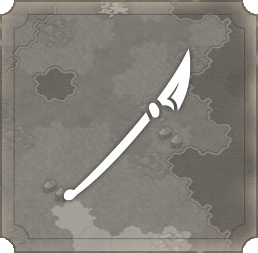

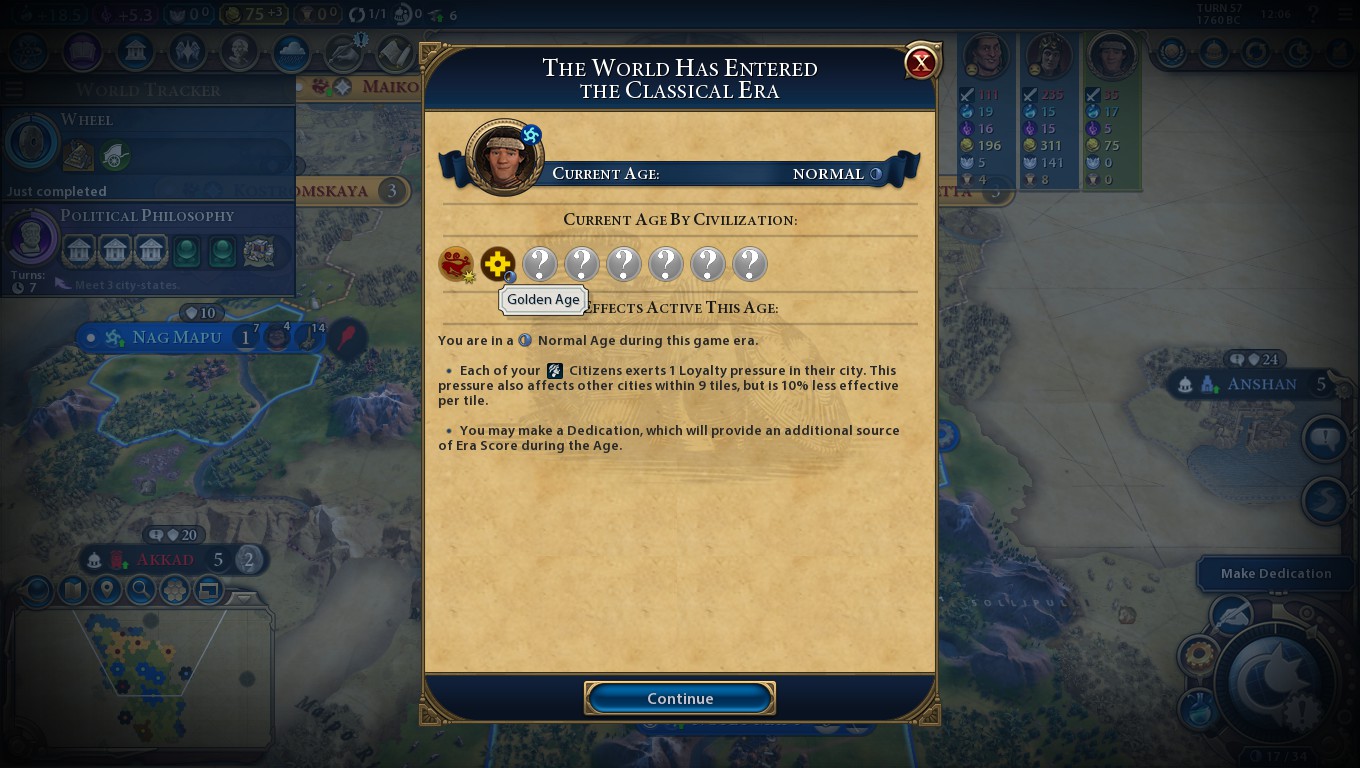
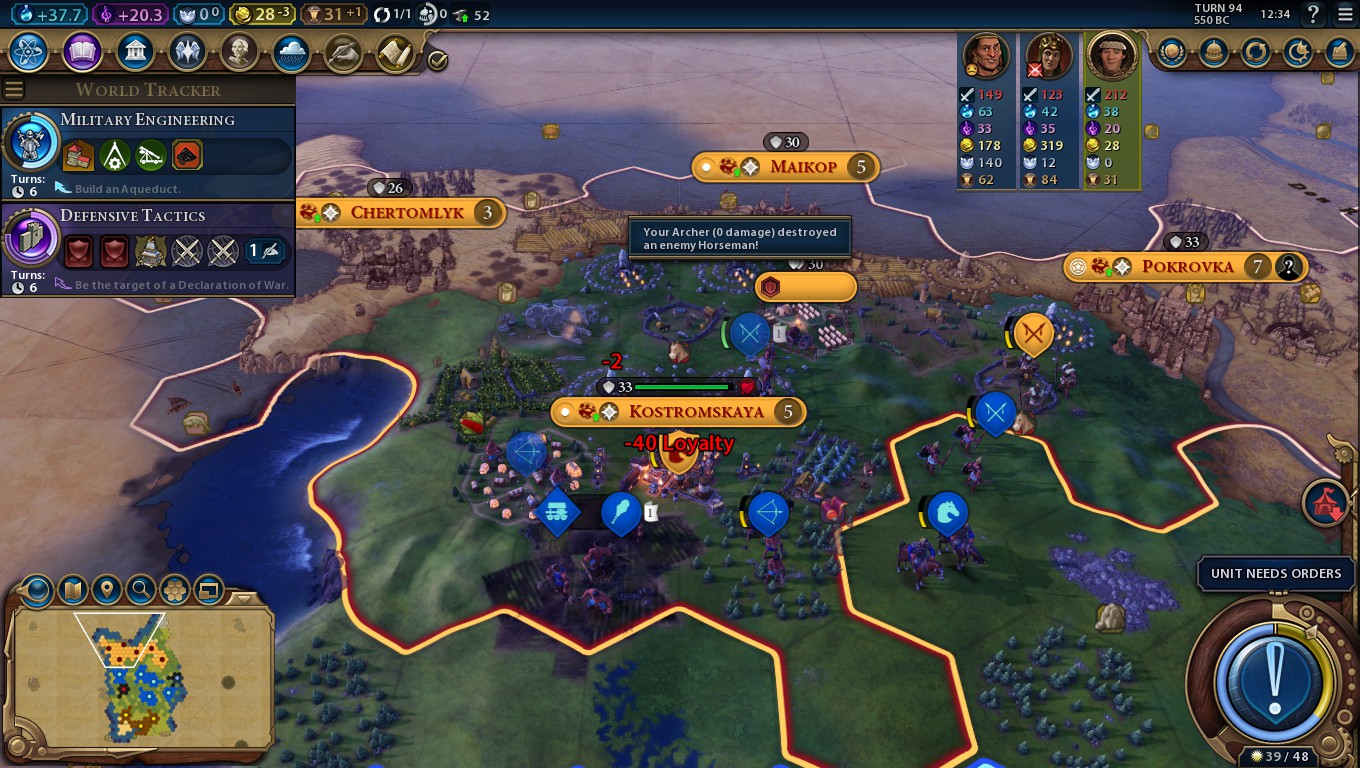

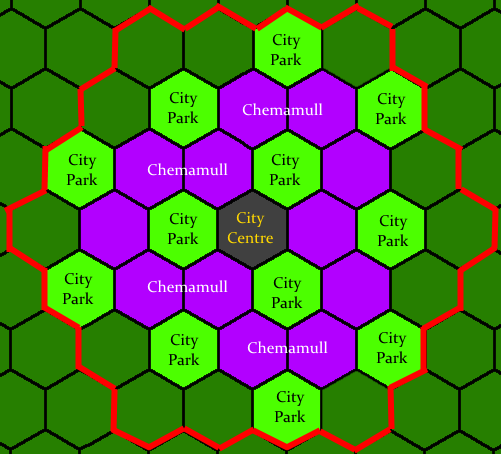
Leave a Reply